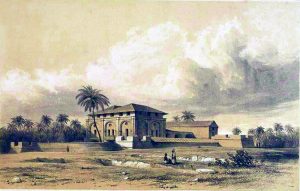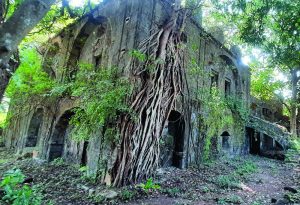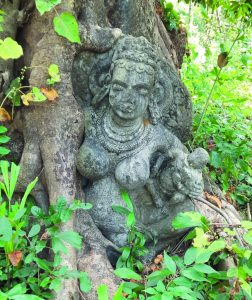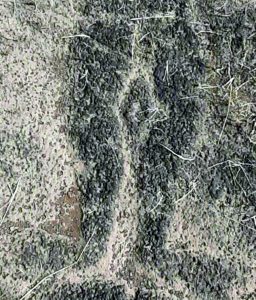India Off the Beaten Track: Walking Back through Time — Mysteries of Konkan

Dutch Factory – lithograph c. 1850
By Shashishekhar Gavai
The Konkan region of Maharashtra offers many attractions: secluded beaches, lagoons ringed with coconut palms and mangroves, lonely roads winding through forested hills, seafood, and other culinary delights, delectable ‘hapus’ mangoes and great sea forts standing guard over the coast like ancient sentinels. I have written about these in an earlier piece on Konkan. My visit this time is to explore dimensions of the history of this land, the mysteries of which I find enticing. And that brings me once again to Sindhudurg, the southernmost district of Maharashtra.
I am in the town of Vengurla, a picturesque harbour with an eye catching lighthouse north of Goa. Also to be found here are remnants of Dutch presence centuries ago. The scramble by European powers for trade in the east saw the establishment of trading companies from the beginning of the 17th century. The English were the first off the mark with the East India Company in 1600, followed by the Dutch, the Danes, the Portuguese and the French. The Dutch set up about two dozen ‘Factories’ or trading posts including one at Vengurla for which they had obtained the permission of the Sultan of Bijapur. They built their Factory here in 1638. The choice from the trade perspective was a curious one and was dictated more by strategic considerations. The Dutch Republic (a rarity in an era of monarchies) was a powerful and prosperous nation. It had its eyes on the lucrative spice trade in Cochin which was then under Portuguese control. The Dutch used Vengurla to exert pressure on their rivals leading to a months-long naval blockade of Goa which was the major Portuguese possession in India. They succeeded in ejecting the Portuguese from Cochin in 1663 after which their interest in Vengurla evaporated and they abandoned their factory in 1682. It was later taken over by the English.

Dutch Factory – present day
Today, almost 400 years after its construction, the Dutch Factory at Vengurla lies in utter ruin, its masonry either collapsed, soon to fall or entangled in vegetation(a scarcely legible notice at the entrance warns that the structure is unsafe). But as I walk through the desolation it appears to me that I am looking at what must have been a handsome edifice. Built in the prevailing European style with large halls and several rooms, it was protected by fortification on its perimeter. A lithograph of the mid nineteenth century bears evidence. A photograph taken in 1909 shows that the building was still in use 300 years after its construction. The site is now under the “care” of the archaeology department of the state government. Its dilapidated condition gives the impression that the caretaker has abandoned its ward.
As I walk out of the ruins in the heat and humidity, I wonder what the scantily dressed native in a turban, dhoti and no footwear, would have thought of the overdressed Dutchman in his tall hat, doublet worn over a long sleeved shirt with broad lace collar, breeches and long boots. Surely such enormously impractical and uncomfortable attire worn in stifling heat by the ‘gora log’ must have provided much amusement to the locals.

Pendur- female with child
Prithviraj Barde teaches science at a local school. He is also a history and archaeology buff who has studied several ancient sites in Konkan. It is at his suggestion that I am in the village of Pendur an hour’s drive from Vengurla. A narrow path by the side of the temple of the local deity Sateri Devi leads me to the forest behind. Here in a clearing, scattered around an ancient stone platform, lie a number of stone carvings in various stages of preservation; some of them executed with considerable artistic skill. There is a statue of Lord Mahavir,founder of the Jain religion; there are Hindu figures in stone and entangled in a tree is a female figure holding a child. Barde has informed me that the artefacts date back a thousand years to the Shilahara dynasty whose kings ruled over Konkan and were patrons of both the Hindu and Jain religions.
It is an eclectic collection and it appears to me that the artefacts may have been found in the vicinity over a period of time and placed in this small area. I find that intriguing. If my impression is true then the forest beyond may hold many more such treasures. And if so, was there an ancient settlement here which has now been covered by the jungle? Only an archaeological exploration may answer the question.
I have read about recent discoveries in Konkan of petroglyphs or prehistoric carvings on rock. Over 70 sites with as many as 1700 petroglyphs have been identified, some of which have been included by UNESCO in its tentative list of World Heritage Sites. These petroglyphs belong to the Mesolithic or middle Stone Age period between 10,000 – 20,000 BCE. Prithviraj Barde has suggested that I visit Kudopi which happens to be on the UNESCO list.

Kudopi – petroglyph
A pleasant drive over a narrow road and through a thick forest brings me to Kudopi village. I find a small group of village folk near the temple and I make my enquiries. One of the group introduces himself as Ashok Walve and offers to lead me to the petroglyphs. His younger kinsman Santosh Walve also joins us. We walk a short distance through the neat little village and then it’s a strenuous climb uphill over a rough track. The foliage overhead protects from the fierce sun until we reach the hilltop which opens onto a plateau covered mostly by rock. There are no trees here and the sun beats upon me mercilessly. It feels like a long walk to the petroglyphs across the plateau and I am exhausted when I get there. As during my trips to the Dutch Factory and Pendur sculptures , I am the only visitor here besides my guides. There are about 40 petroglyphs of various sizes spread over a fairly large area. I see figures of humans, animals and some intriguingly abstract designs carved over the rocky terrain. With only the primitive tools of the Stone Age available to them our Mesolithic ancestors must have possessed considerable talent and tenacity to create this prehistoric art gallery.
So who were these people and where did they come from? Santosh Walve who hasn’t travelled much beyond his village, tells me that it was the Pandava brothers (of Mahabharata fame). Ashok Walve who has lived and worked in Mumbai shakes his head sceptically. We don’t know who these people were, he says. I imagine that Erich Von Daniken, that writer of many unbelievable bestsellers and pseudo archaeologist , would attribute these creations to extraterrestrials without batting an eyelid, were he to visit. The answer may well lie at Koloshi, about 20 kilometres from here as the crow flies. Recently in a cave here stone tools of the Palaeolithic or old Stone Age period have been discovered. These are estimated to be about 50,000 years old. Our petroglyph artists may well be the descendants of the makers of these tools.
On the way back Santosh invites me to his dwelling in the village where I meet his wife. After a drink of cool and refreshing water from the spring which supplies the village, the hospitable couple offers me tea and homemade laddoos. The sugary tea sends a burst of energy coursing through my rather weary person. I don’t think I have ever felt so grateful for a cup of tea. Ashok then insists I have lunch at the village temple. Today happens to be one of the two auspicious days in the year when lunch is offered by the temple to villagers. It is lunchtime and I accept the invitation. It’s simple fare – rice, dal and a vegetable curry served on an eco friendly plate crafted from leaves.
